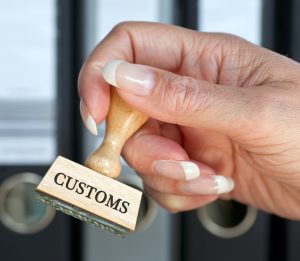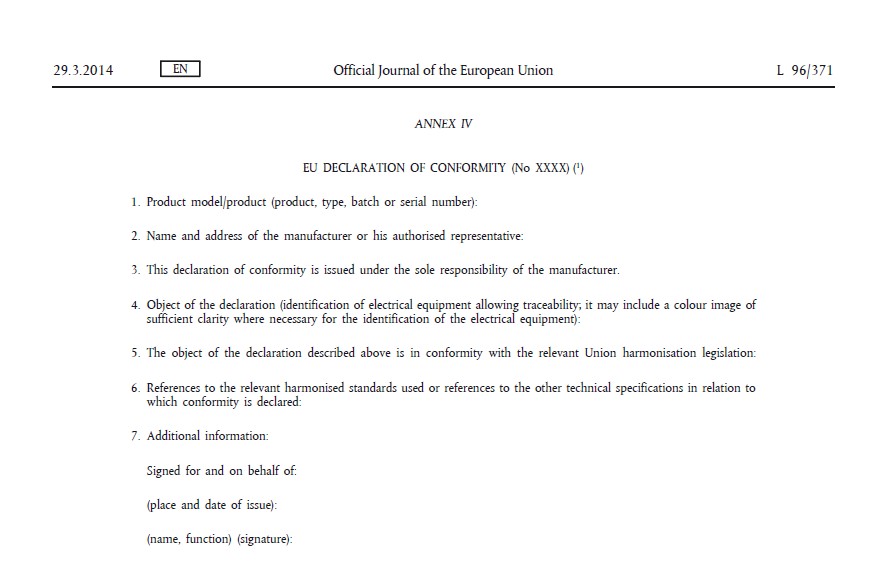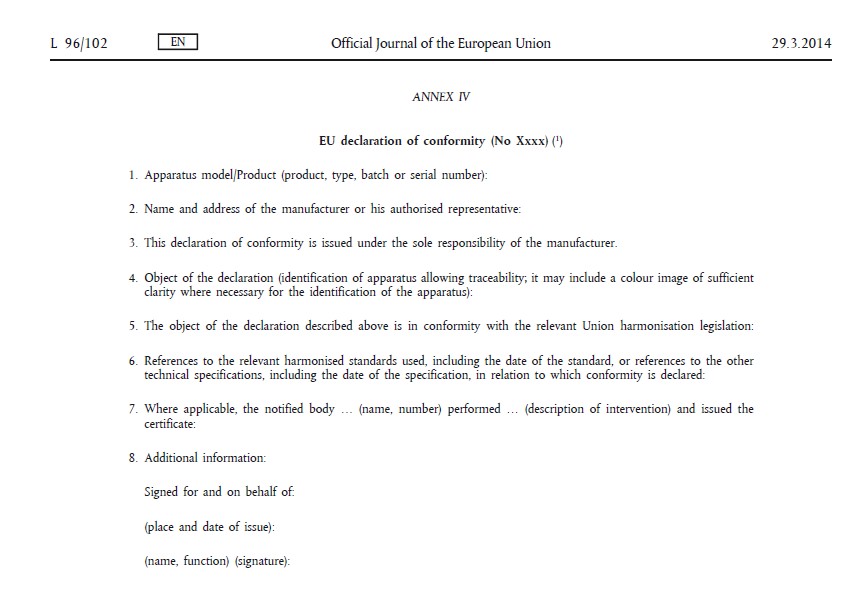
A frequent source of confusion for exporters of products to the EU is the EU declaration of conformity. Many customers that we assist are vaguely familiar with the concept and the role of the “DoC”.
The EU declaration of conformity is a one-page (usually) document that indicates the following information:
- Manufacturer name and address.
- Product name, type, model, and serial number (or other traceable information such as batch number).
- CE markings to which the manufacturer is claiming compliance for the subject equipment.
- Harmonized EN standards which the manufacturer used to design and evaluate the equipment.
- Declarative statement that the equipment is in compliance with the indicated Directive(s).
- Signature by a company officer.
Additional items which may be indicated but are not required are:
- Test report numbers.
- The 3rd party lab engaged for technical intervention by the manufacturer (i.e., a lab hired by the manufacturer to identify applicable Directives and EN standards and then test).
- Other standards which are not harmonized EN standards, for instance, IEC standards.
Some of the items we commonly see on declarations of conformity which are not correct are:
- Directives listed that are not applicable (for example, indicating any reference to the Pressure Equipment Directive 2014/68/EU when the PED is excluded.
- Directives that are not CE marking Directives, for example the General Product Safety Directive 2001/95/EC or the WEEE Directive 2012/19/EU.
- Omitted Directives
- Indicating the Machinery Directive 2006/42/EC and the Low Voltage Directive 2014/35/EU: this is technically illegal.
- Expired Directives.
- Expired standards.
Prior to 2016 the role of a regulatory affairs professional was made slightly more complex by the differing requirements and formats of DoC’s in the myriad of different Directives. However, the recasting of many Directives as a part of the New Legislative Framework of 2008 (aka NLF) simplified the process. Many Directives were rewritten, primarily to clarify definitions and responsibilities but also to streamline some of the requirements, like the EU declaration of conformity.

This means that if you have a product that is in the scope of the Low Voltage Directive 2014/35/EU and the EMC Directive 2014/30/EU you will not have to look at two vastly different declaration of conformity templates in both Directives and hope that you covered everything indicated in both Directives. We note that the Machinery Directive 2006/42/EC was not recast as a part of the NLF and there are slightly different, but important, requirements for it.
See below the model structure as indicated in Annex IV of the Low Voltage Directive 2014/35/EU:

Next, see the model structure as indicated in Annex IV of the EMC Directive 2014/30/EU:

Note there is an additional item in the EU declaration of conformity under the EMC Directive. This is for the inclusion of information regarding the technical intervention of a Notified Body, for example if an EU-type Examination Certificate was issued. Since there is no role for a Notified Body in the Low Voltage Directive 2014/35/EU that is not included in Annex IV of 2014/35/EU.
Once the format for the EU declaration of conformity is understood, the equipment is compliant, and the document is drafted and signed… what next?
We advise all clients to translate the document and include it with every product sent to the EU. The best place for this is printed in the product documentation: the manual.
“How do we print a serial number for each one in its own unique manual?”
That is a common question. The answer to that is to print a range of serial numbers for the product and reserve them for that product. The idea is that an inspector or quality manager in the EU must be able to pick up your product, look at the nameplate, and match it definitively to the serial number or batch number indicated on the declaration of conformity. It is advisable to make this correct and as transparent as possible. The main issues we hear from customers who have their products stopped, questioned, or seized by market surveillance authorities in the EU is due to a sloppy, incorrect EU declaration of conformity.
Finally, we note that technically, for many Directives it is not required that you send the declaration of conformity with the product. The requirement is that you keep it together with the technical file for ten years so that you can hand it over to the authorities if questioned.
Our strong advice is this: You did everything right. You designed the product safely and engaged an A2LA accredited laboratory like F2 Labs to evaluate and test the product so that you could legally export it to the EU. Why not provide the declaration of conformity with the product so that any questions about the compliance of it are answered before a formal inquiry can be made?
As a younger man, I trained at Parris Island during which I witnessed… many things. I will tell a story of one of those things that I remember to this day. I was a recruit and standing at attention in the 2nd Battalion barracks. A hard rule in the Marines, and it starts on day one is this: ALWAYS LOCK UP YOUR VALUABLES. On that day, a drill instructor walked by us as we stood at attention and noticed that the end of a string was hanging from underneath the lid of the footlocker belonging to the guy across the squad bay from me.
The next thing we all saw was this Marine Corps Drill Instructor on his knees pulling and tugging on this string until he pulled out the guy’s USMC-issued money valuables bag from a still-locked footlocker. Then he dumped it out all over the deck and started going through it, including love letters from the guy’s girlfriend, which he read to all of us.
Don’t give an EU market surveillance authority a string to pull on.
Make sure your EU declaration of conformity is correct.
F2 Labs is here to help. Have a question or a comment? We can be contacted via this link. We can be reached by phone at 877-405-1580 and are here to help you.

